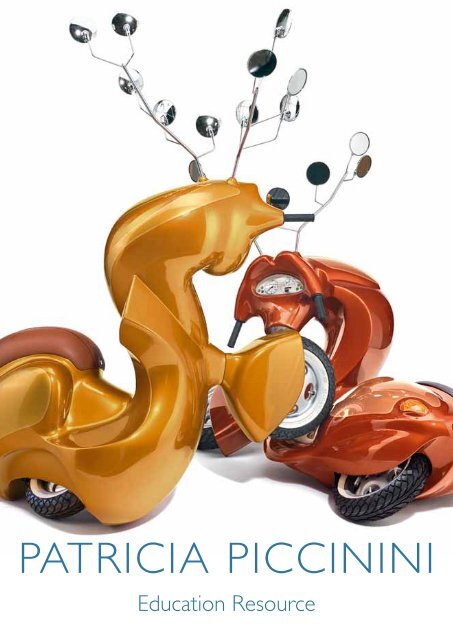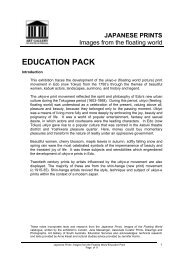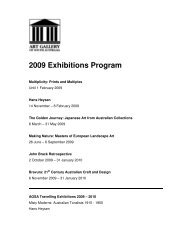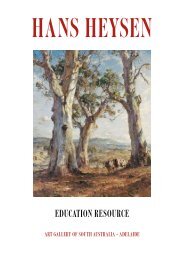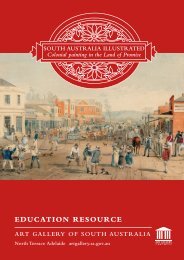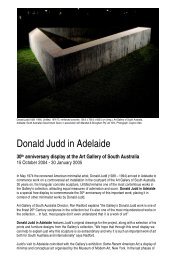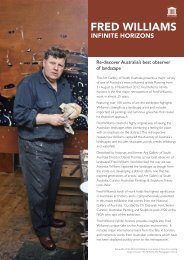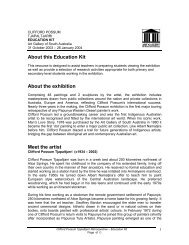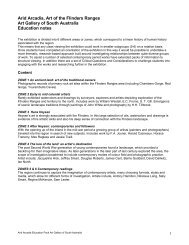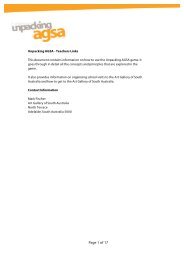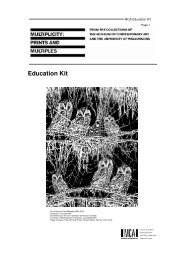Patricia Piccinini - Art Gallery of South Australia - SA gov au
Patricia Piccinini - Art Gallery of South Australia - SA gov au
Patricia Piccinini - Art Gallery of South Australia - SA gov au
You also want an ePaper? Increase the reach of your titles
YUMPU automatically turns print PDFs into web optimized ePapers that Google loves.
<strong>Patricia</strong> <strong>Piccinini</strong><br />
Education resource<br />
1
introduction<br />
the exhibition <strong>Patricia</strong> <strong>Piccinini</strong>: Once upon a time… introduces an exciting world where we are able to discover<br />
many fantastical creatures in unusual settings.<br />
<strong>Piccinini</strong>’s sculpture, installation, video work, photography and drawing, transport us to strange locations that are<br />
nevertheless eerily familiar.<br />
the exhibition is drawn primarily from private collections, and also includes new works created by the artist and seen<br />
for the first time at the art <strong>Gallery</strong> <strong>of</strong> <strong>South</strong> <strong>au</strong>stralia. the works span the artist’s career to date.<br />
<strong>Piccinini</strong> invites us to think about our place within a time when biotechnology and digital technologies are challenging<br />
the boundaries <strong>of</strong> humanity. confronting us with her seemingly grotesque hybrid beings and anthropomorphic<br />
machines, she invites us to find be<strong>au</strong>ty in a world that can never be perfect.<br />
in the exhibition book, curator Jane Messenger comments:<br />
in recent years … <strong>Piccinini</strong>’s critique has expanded to include an investigation <strong>of</strong> evolutionary biology and how the<br />
machine – that invention that now dominates contemporary society – may, by developing animalistic patterns <strong>of</strong><br />
behaviour, become a sentient and <strong>au</strong>tonomous being. although her work is primarily full <strong>of</strong> hope … it does contain<br />
dark undercurrents.<br />
these undercurrents concern new technologies, scientific manipulations, the customising <strong>of</strong> life. We are led to consider<br />
how we will respond to and manage the outcomes <strong>of</strong> bio-technological advances.<br />
2
tEachErS’ notES<br />
this education resource has been prepared by Education Services to support the exhibition <strong>Patricia</strong> <strong>Piccinini</strong>: Once<br />
upon a time… and is intended as a guide to assist teachers <strong>of</strong> primary and secondary students in generating ideas and<br />
guiding learning before, during, and following a visit to the exhibition.<br />
the resource can be adapted for different contexts and year levels. it has been designed to integrate with the <strong>South</strong><br />
<strong>au</strong>stralian curriculum Standards and accountability Framework, with particular focus on Learning areas.<br />
it links most directly to:<br />
• <strong>Art</strong>s – Visual <strong>Art</strong>s:‘<strong>Art</strong>s in context’ and ‘<strong>Art</strong>s analysis and response’<br />
• Society and Environment:‘Place, space and environment’<br />
• Science:‘Earth and space’ and ‘Living systems’<br />
the aim <strong>of</strong> this resource is to <strong>of</strong>fer insights into <strong>Piccinini</strong>’s practice, works <strong>of</strong> art, and major themes. it is intended as a<br />
starting point for generating ideas, for encouraging student research, and as a basis for discussion during and following<br />
exhibition visits. the resource introduces key works <strong>of</strong> art, provides background information on the artist, and <strong>of</strong>fers<br />
questions and suggested activities.<br />
this resource can be used in a variety <strong>of</strong> ways, both for student groups, as well as for individual study and research. the<br />
material is intended to complement the information provided in the exhibition book, <strong>Patricia</strong> <strong>Piccinini</strong>: Once upon a<br />
time…<br />
teachers are invited to adapt the resource to suit their students’ needs, or select and integrate sections into existing<br />
units <strong>of</strong> study.<br />
Pre-visit learning<br />
• Download the education resource and view this prior to visiting. www.artgallery.sa.<strong>gov</strong>.<strong>au</strong>/learning<br />
• Ask questions: What do students already know about contemporary artistic practice in <strong>Australia</strong>?<br />
What do I want students to experience, appreciate, and learn as a result <strong>of</strong> this visit?<br />
• Encourage research and discussion on the exhibiting artist, including her use <strong>of</strong> a team <strong>of</strong> specialists at Drome<br />
studio, Melbourne: modellers, cast makers, spray painters, hair punchers, editors, and video and production<br />
workers to complete her works.<br />
• Visit <strong>Patricia</strong> <strong>Piccinini</strong>’s website www.patriciapiccinini.net and explore other works.<br />
Key terms in bold are defined in the Glossary at the end <strong>of</strong> this resource, where ideas for post-visit learning are also<br />
included.<br />
Learning at the exhibition<br />
as students view the exhibition, they are encouraged to think creatively, and take nothing for granted. the following<br />
themes and concepts integral to <strong>Piccinini</strong>’s work might provide the basis for student discussion:<br />
• care and responsibility toward what we create (or destroy)<br />
• the blurring <strong>of</strong> boundaries between science, technology and humanity, particularly between humans and machines<br />
• what it means to be human (or family) in a world in which boundaries are blurred: our place at this time –<br />
and in the future<br />
• the possibilities (and drawbacks) <strong>of</strong> biotechnology<br />
• our relationship to the environment, to the natural and the artificial<br />
• consumerism in contemporary society<br />
• life and death, and ideas <strong>of</strong> salvation and sacrifice<br />
• identity (and what we identify with)<br />
• how we manage / respond to difference and change<br />
• contemporary art practice, and how advances in science and technology have created new possibilities for artists.<br />
3
aLoFt<br />
This large scale work (it weighs 100 kgs!) looks real, but it’s not something we would find in our real world.The artist<br />
imagines different worlds in which we will recognise some things, but not others.<br />
Similar to other sculptures in the exhibition, al<strong>of</strong>t is constructed from a wide range <strong>of</strong> materials including fibreglass,<br />
felted human hair and wool, steel cable, silicon, horse hair, clothing, and electronic motors.<br />
here a young boy is peeping over the edge <strong>of</strong> a large, bulging egg sack, suspended from the centre <strong>of</strong> a web. the<br />
boy seems curious and untroubled – comfortable as he looks at the world beneath him, relaxed in his surroundings,<br />
however strange these may seem to us.<br />
this hairy egg sack has been fashioned from human hair. Many hairdressers and volunteers in Melbourne were<br />
involved in collecting and sorting the quarter <strong>of</strong> a tonne <strong>of</strong> hair required for the work! Human hair has also been used<br />
in newborn, the long awaited, the young family, and several other works.<br />
Questions and activities<br />
Primary<br />
• On the way down the stairs, what do you see? At the bottom <strong>of</strong> the stairs, look up at al<strong>of</strong>t. how does it look<br />
different from this view?<br />
• Why do you think the boy has climbed in, and is now peeking over the edge? Has he been exploring?<br />
• What is going on inside the sack? Have the grubs been hibernating in this nest? What might finally emerge?<br />
• How do you feel about these imaginary grubs building a home in our <strong>Gallery</strong>?<br />
Secondary<br />
• What are the various elements which make up this work <strong>of</strong> art? Does your reaction to the work change as you<br />
move around and past the work? Does a change in perspective influence your interpretation <strong>of</strong> the work, or add<br />
to a developing narrative?<br />
• Does this strange organic form seem at odds with its environment?<br />
• This work refers to the idea that it is the right <strong>of</strong> humans to go into the environment <strong>of</strong> other species and take<br />
(or destroy) what they want. Does it seem different when an imagined species invades our <strong>Gallery</strong>? Discuss.<br />
4
thE younG FaMiLy<br />
this work was inspired by scientists’ plans to begin breeding genetically-modified pigs to provide replacement<br />
organs and insulin-producing cells for humans, thus alleviating shortages <strong>of</strong> human organs for transplant, and treating<br />
diabetes. the work is not about whether such practices are right or wrong, but rather whether society will accept the<br />
outcomes <strong>of</strong> these developments.<br />
The artist has commented:‘For me, the young family is about the ethical implications <strong>of</strong> creating new life to serve<br />
humans, and also about the interaction between emotion and rationality when thinking about these “creation” issues.’<br />
This young family has been created by ‘mixing’ together two or more genetically different animals.They are chimeras.<br />
What animals are you reminded <strong>of</strong> when you look closely? The mother is shown suckling two babies. She seems<br />
exh<strong>au</strong>sted and sad. her gaze is vacant. the playful pup is in a pose very like one in which babies are <strong>of</strong>ten seen, lying<br />
on their backs, playing with their toes. is the artist perhaps suggesting that there is not a great distance between<br />
animals and humans? Despite the fact that these are creatures imagined by the artist, the young family looks very real.<br />
Questions and activities<br />
Primary<br />
• Look at the expression on the mother’s face.What does this expression suggest she might be thinking and<br />
feeling?<br />
• Find out about the range <strong>of</strong> human organs which are able to be transplanted.<br />
• Discuss in class whether you think organ donation and transplantation are good ideas?<br />
Secondary<br />
• The artist has commented:<br />
i am interested in the kind <strong>of</strong> ways that we look at the many ethical issues that surround medical technologies.<br />
there are two kinds <strong>of</strong> people who are thinking about these issues; those who are objective observers and those<br />
that are actually affected by the issues, such as somebody who has a family member who is affected by a disease.<br />
these are two different viewpoints…<br />
Public Lecture – Tokyo <strong>Art</strong> University 2003<br />
How does this work make you feel about advancements in medical technology?<br />
• What is the nature <strong>of</strong> our relationship with animals? We use animals as ‘machines’ that produce eggs, milk, meat<br />
and now, body parts for humans. Are we exploiting animals for our own gain? Have scientists over-stepped the<br />
mark? What are your views?<br />
• Later, research the work and writings <strong>of</strong> the ethicist / philosopher Peter Singer on animals and pain.<br />
5
BiG MothEr<br />
(illustrated next page) the inspiration for this work arose from the artist hearing a true story about a female baboon<br />
whose baby had died while still nursing. the baboon, overwhelmed by grief, abducted a human child as a substitute.<br />
the child was later recovered unharmed.<br />
the artist has created Big Mother with many characteristics <strong>of</strong> a baboon. She is nearly two metres high, and stands tall<br />
and upright, just as we do. She is gently holds and feeds a human baby, a protecting, nurturing and loving action which<br />
shows that humans and animals care for their young in similar ways. the baby is obviously calm and relaxed: notice<br />
the position <strong>of</strong> its hand, resting against Big Mother’s breast.<br />
When looking at the work we can imagine different stories: is this mother a specially engineered primate who has<br />
been bred to be a wet nurse? Is she some kind <strong>of</strong> helper, carer or babysitter?<br />
Primary<br />
Questions and activities<br />
• Why is Big Mother so sad?<br />
• If Big Mother could talk, what do you think she would say to you about being a mother?<br />
• What is your first impression on looking at this sculpture? Does your impression change as you walk around the<br />
sculpture and examine it more closely?<br />
• Why has the artist included bags in the work? What might be in the bags?<br />
Secondary<br />
• <strong>Piccinini</strong>’s sculptures have been described as ‘terrifying and awe-inspiring, repulsive and alluring . . .’<br />
(Messenger, exhibition book)<br />
this comment suggests that we might have a mixed response to <strong>Piccinini</strong>’s work. What were your responses to<br />
Big Mother?<br />
• The artist is interested in notions <strong>of</strong> family. Discuss in class your interpretation <strong>of</strong> family, or what constitutes a<br />
family in contemporary – or future – society?<br />
• How does this particular depiction <strong>of</strong> ‘nurturing,’ both physical and emotional, question what it is to be human?<br />
6
thE StaGS<br />
this sculptural work cleverly mixes the appearance and features <strong>of</strong> animal and machine. it combines the shape <strong>of</strong> the<br />
popular Italian motor scooter, the Vespa, and the muscular form <strong>of</strong> a male deer, a stag. A hybrid form is created.<br />
The artist has ‘imagined’ two scooters behaving as animals – as stags fighting, perhaps over territory, or females, as<br />
animals do in the wild. there is a remarkable sense <strong>of</strong> movement achieved in the sculpture, with the shiny sinuous<br />
bodies seeming to twist and writhe. one stag is clearly dominant, the other appearing almost to cringe in defeat. the<br />
defeated stag looks bewildered – look closely at its ‘dial’! The work raises issues about what is natural, and what is<br />
mechanical, and about power and hierarchies in groups or communities. Who will survive: the fittest, the strongest,<br />
those bred for particular conditions?<br />
The work also reflects another <strong>of</strong> <strong>Piccinini</strong>’s favourite themes: consumerism. In Italy,Vespas are seen as symbolic <strong>of</strong><br />
style and class. they are very desirable, even though not always practical.<br />
Questions and activities<br />
Primary<br />
• In the world the artist imagines, the boundaries between machine and animal become increasingly blurred.<br />
Imagine what would happen in our world if machines became ‘human’! Talk about this possibility with a classmate.<br />
• Choose a machine from your home or shed, and show in a drawing how it could become ‘human’.<br />
Secondary<br />
• Create a series <strong>of</strong> photographic images <strong>of</strong> mechanical objects and using a computer program, imagine and<br />
animate your favourite image as an animal.<br />
• Research developments in medical science / technology where new mechanical interventions and attachments<br />
are improving the lives <strong>of</strong> sick or disabled people.<br />
• The fact that the machines in this work are free to be <strong>au</strong>tonomous, and interact as they wish, brings an onerous<br />
tone to a seemingly ‘bright’ work.They take on a life <strong>of</strong> their own. Discuss how developments in technology may<br />
have both a ‘bright’ and a dark side.<br />
8
trucK BaBiES<br />
These sculptures have been created as the ‘babies’ <strong>of</strong> large (adult!) road trucks, remembered by <strong>Piccinini</strong> after a road<br />
trip in america during which she drove from new orleans to niagara Falls. With their rounded forms, prominent<br />
bottoms and little wheels they are very appealing, unlike their large and noisy ‘parents’ which thunder past us on vast<br />
highways.The colours the artist has used ‘humanise’ the truck babies: baby pink for girls and baby blue for boys. We<br />
think ‘How cute!’<br />
this work is about how it is now possible to see machines in terms <strong>of</strong> animals. it is about how we might talk to our<br />
computers, and also think that our car has a personality. in this new world, the truck babies need the Big sisters, tokyo<br />
girls who are technologically savvy, to help them lead a fulfilling life.<br />
this is another work in which <strong>Piccinini</strong> explores the theme <strong>of</strong> families, and <strong>of</strong>fspring. She is also interested in how,<br />
particularly as consumers, we respond to objects which are ‘cute’, as opposed to those which are less visually<br />
appealing. She has commented on her website:‘I am fascinated by the variety, complexity, be<strong>au</strong>ty and seduction <strong>of</strong><br />
consumerism’.<br />
in contemporary culture consumers crave the stylish and colourful; the shiny; the latest models, with glossy surfaces<br />
and shiny chrome. and we can be easily seduced by fads. the accompanying video work focuses on young women<br />
deemed by <strong>Piccinini</strong> to be perfect consumers for the truck babies.<br />
9
car nuGGEtS GL<br />
Other works here have an ‘<strong>au</strong>to’ or car focus. Heart Breaker and Blaze are from the car nuggets GL series. these<br />
fibreglass sculptures represent cars which have been transformed, or compressed, as if distilled down to their essence.<br />
Is this a kind <strong>of</strong> minimalism?<br />
These moulded forms with their fluid, shiny surfaces are instantly appealing, like the team WaF helmets. they remind<br />
us <strong>of</strong> gleaming, newly-manufactured and polished cars that are objects <strong>of</strong> desire for consumers.<br />
10
TEAM WAF (PRECAUTIOnS)<br />
The ‘helmets’ look very appealing – bright colours and designs, shiny, and we might be very tempted to want one. But<br />
look at the unusual shapes: Are they useful or practical objects? Would they protect us, as a helmet should? If not us,<br />
who? What kind <strong>of</strong> head have they been made for? They have obviously been designed for strange, non-human heads.<br />
For future beings? These heads may be ‘different’ or even ‘disabled,’ but still need the helmets to drive fast cars.<br />
the title <strong>of</strong> the work suggests a group, like a family, perhaps a family <strong>of</strong> bikes, or bike racers. and these helmets are<br />
further humanised or individualised in their names / labels: Hornet, transfuser, Offspring (this last ‘name’ reminiscent <strong>of</strong><br />
the truck babies . . .) What do these names suggest to you?<br />
Primary<br />
Questions and activities<br />
• Look at the photograph Mountain nearby. is this perhaps the land the truck babies originated in?<br />
• Why has the artist used the word ‘nuggets’ for her sculptures? What other things do you know that are<br />
described as nuggets?<br />
• Using plasticine, make a ‘baby’ model <strong>of</strong> a familiar machine or appliance.What would you do to make your model<br />
appeal to a consumer?<br />
Secondary<br />
• What do you think truck babies and team WaF and the car nuggets have in common?<br />
• <strong>Patricia</strong> <strong>Piccinini</strong> has described truck babies as ‘a cute work, full <strong>of</strong> humour, but at the same time quite serious.<br />
it asks questions about the “nature” <strong>of</strong> contemporary society – and the increasingly strange and confused<br />
relationship between what we see as “natural” and “artificial”’. What is your response to truck babies?<br />
11
GAME BOyS ADVAnCED<br />
In this sculpture we see two boys who look like twins.They are focused on a hand-held computer game – ‘Game<br />
Boy’. But on closer look it seems that they are not boys at all. they have loose, blemished skin, wrinkled eyes – and<br />
ear hair! These are characteristics <strong>of</strong> a much older person.The work draws on <strong>Piccinini</strong>’s interest in evolution, genetic<br />
engineering, and technology.<br />
the boys have been cloned. the idea for this work came from developments in the cloning <strong>of</strong> genes. <strong>Piccinini</strong> is<br />
interested in the promise <strong>of</strong> genetic engineering, but acknowledges in her work that it can have bad outcomes as well<br />
as good.What will become <strong>of</strong> the unexpected or undesirable outcomes, <strong>Piccinini</strong> has asked? ‘Will we love the failures<br />
<strong>of</strong> new technologies as much as we love the successes?’<br />
the first cloned mammal was dolly, a sheep cloned from a mammary cell <strong>of</strong> an adult ewe, in Scotland in 1996. there<br />
was a good deal <strong>of</strong> interest in this development, and much controversy. dolly aged prematurely and did not live<br />
as long as expected, and this was possibly bec<strong>au</strong>se she was cloned from a ewe already six years old. the unnatural<br />
environment in which dolly was raised may also have contributed to her early death.<br />
in this work <strong>Piccinini</strong> is imagining future possibilities, although perhaps the possibilities are actually not too distant. it<br />
is interesting that the boys do not seem concerned about their situation. they are ageing prematurely, but they look<br />
quite content, absorbed in their game, just as we would expect young boys to be.<br />
Questions and activities<br />
Primary<br />
• Would you like a scientist to be able to create another you? Think about whether you would change anything,<br />
and if you would, why?<br />
• Do you feel sympathy for the boys – or something else?<br />
• If you could ask the boys some questions, what would they be?<br />
Secondary<br />
• What do you think the artist has intended by using the word ‘advanced’ in the title?<br />
• Find out more about cloning, and what scientists hope to achieve (or can already achieve). Discuss with<br />
classmates the ethical issues around cloning. Many argue that cloning and gene therapy are wrong, bec<strong>au</strong>se they<br />
interfere with nature.What are your views?<br />
12
SurroGatE<br />
Surrogate was designed by the artist as one <strong>of</strong> her natures little helpers series, biologically engineered to help the<br />
northern hairy-nosed Wombat, endangered through drought, dingo attacks, and urban development. it nurtures<br />
wombat embryos in its pouches which run along its back. on close examination we see each wombat at a different<br />
stage <strong>of</strong> growth. Some are newborns, while others are almost ready to leave their pouch. the Surrogate must have<br />
patience and persistence, for its job is never done.<br />
this imagined creature sits outside its custom-made blue leather tent, designed to <strong>of</strong>fer protection from the weather,<br />
and bec<strong>au</strong>se he has no fur or hair covering his skin. the tent might also provide safety against predators.<br />
the artist looks to question the extent to which we will use biotechnology in our attempts to undo the damage we<br />
have done to the environment.<br />
BottoM FEEdEr<br />
Bottom feeder is another <strong>of</strong> nature’s little helpers. this strange custom-designed creature, with a shark’s head, human<br />
body and legs like a dog, has the task <strong>of</strong> devouring rubbish. it provides a cleaning service.<br />
BodyGuard<br />
Bodyguard is another <strong>of</strong> the artist’s creations for the nature’s little helpers series. Bodyguard was designed as a means<br />
for protecting the Golden Helmeted Honeyeater, an endangered bird found in Victoria.Very few <strong>of</strong> these birds are left<br />
in the wild bec<strong>au</strong>se <strong>of</strong> habitat degradation c<strong>au</strong>sed by urban growth. the fierce-looking bodyguard is perched on a<br />
custom-made synthetic ‘tree’. Its posture suggests that it is ready to repel both human and non-human threats. It has<br />
sharp fangs, a strong jaw, and powerful human-like hands. its bulging eyes suggest that it is constantly alert.<br />
With these three sculptures the artist is focusing on themes which interest her – the environment and evolution.<br />
13
Primary<br />
Questions and activities<br />
• Do you find these sculptures frightening or confronting? Why? Or why not?<br />
• Later, find out more about the northern Hairy-nosed Wombat which is the subject <strong>of</strong> Surrogate, and its natural<br />
environment. How are we managing to protect the remaining northern Hairy-nosed Wombats?<br />
• The artist has described the Bottom feeder creature as ‘be<strong>au</strong>tiful’.What do you think? Imagine how this creature<br />
might move to devour the rubbish!<br />
Secondary<br />
• Surrogate was inspired by an exhibition which looked at the use <strong>of</strong> cloning and ancient dna to revive the<br />
tasmanian tiger, an <strong>au</strong>stralian marsupial wolf hunted to extinction in the early twentieth century. Should we be<br />
developing new life to save endangered species, such as the northern hairy-nosed Wombat, when we still have<br />
no cure for cancer? What are your views?<br />
• Recently, a well-known couple used a surrogate (referred to as a ‘gestational carrier’) to give birth to their child.<br />
What do you think? Is this where the future is headed?<br />
• Later, design and create your own nature’s little helper.What would it do, or protect?<br />
14
SandMan<br />
this installation incorporates sculpture, moving image and photography.<br />
Sandman grew out <strong>of</strong> <strong>Piccinini</strong>’s interest in car culture, specifically the culture <strong>of</strong> panel vans which were very popular in<br />
<strong>Australia</strong> in the 1970s and 80s.The yellow car seen in the photographs is an example <strong>of</strong> the Sandman panel van. Panel<br />
vans achieved iconic status in <strong>au</strong>stralia. once identifiable as tradesmen’s vans, they came to be associated with youth<br />
culture, symbolising a time <strong>of</strong> adolescent freedom – growing up and escaping to the beach with friends, travelling the<br />
coast with your surfboard. But as well as having a collective cultural meaning, panel vans were <strong>of</strong>ten individualised or<br />
‘customised’ by their owners with elaborate artwork or slogans painted on the van body.<br />
the installation features a number <strong>of</strong> themes found in <strong>Piccinini</strong>’s works, including transition and transformation, and<br />
evolution.The yellow panel van in the photographs has fish-like ‘gills’ cut into the car body near the front wheels.There<br />
is a visual connection (or link) with the van and the girl in the video and photographs. Look closely and you will see<br />
that she has what look like gills on her neck. these are branchial arches, which in humans become parts <strong>of</strong> the throat<br />
and inner ear as a foetus develops. they are an evolutionary link back. in the young girl here, however, remnants <strong>of</strong><br />
what would normally disappear remain.<br />
the ideas <strong>of</strong> transformation and transition link the elements <strong>of</strong> the installation. it is a work in which we seem to be<br />
given diverse but linked pieces <strong>of</strong> information about these themes. the strange dark sculpture, rather sinister in shape,<br />
represents a panel van that has been transformed: it has morphed into an entirely new ‘car’ form, reminiscent <strong>of</strong> a<br />
deep sea creature. the yellow panel van perhaps prompts ideas <strong>of</strong> cultural transformation. it is now thirty or forty<br />
years since panel vans <strong>of</strong> this type were popular and widely acknowledged as symbols <strong>of</strong> our culture. they are now<br />
relics; things have moved on. and the adolescent girl will move on too: she will become an adult.<br />
there is a melancholy feeling to the work. the girl’s physical difference may mean that she feels isolated, and alienated,<br />
that she doesn’t belong. these feelings are <strong>of</strong>ten associated with adolescence. another theme important to <strong>Piccinini</strong> is<br />
evident here – the idea <strong>of</strong> belonging, <strong>of</strong> being part <strong>of</strong> a family.<br />
Swimming out to sea looks like hard work for the girl. as she sinks the scene is serene – unlike the grey and stormy<br />
world on the surface – though what happens to her remains ambiguous.<br />
Questions and activities<br />
Primary<br />
• Which <strong>of</strong> the elements <strong>of</strong> the installation most appealed to you – the car sculpture, the photographs or the<br />
video? Why?<br />
• Using plasticine, create a sculpture that is your own ‘re-working’ <strong>of</strong> your favourite car.<br />
• Create a design which you would use to ‘customise’ your own car.<br />
• What does the giant sea creature that swims past the girl in the film remind you <strong>of</strong>?<br />
Secondary<br />
• The yellow Sandman has the word ‘Xanadu’ written across the back.What meanings / associations does this<br />
word have? How might these associations be relevant to this installation?<br />
• What roles do the objects which become ‘icons’ play in our culture?<br />
• Create a ‘photographic table<strong>au</strong>’ on the theme <strong>of</strong> adolescence and freedom.<br />
• Compare and contrast Sandman with another installation in the exhibition, Perhaps the world is fine tonight, in<br />
terms <strong>of</strong> themes and cultural references.<br />
15
StiLL LiFE With StEM cELLS<br />
In this work we see a little girl on the floor playing with strange flesh-like lumps, <strong>of</strong> various shapes.These lumps look<br />
like living tissue, and show human characteristics such as mottled skin, fine hair, and veins. the title <strong>of</strong> the work suggests<br />
that these lumps were created in a laboratory from stem cells. these are cells that are able to be transformed into<br />
any other kind <strong>of</strong> cell in the human body, such as skin, heart, kidney, lung, or brain cells. they are very important for<br />
medical research. they <strong>of</strong>fer the potential <strong>of</strong> cures for diseases, and a life free <strong>of</strong> sickness.<br />
the bio-technologies that are <strong>of</strong> interest to the artist were unimaginable even twenty years ago, but are now widely<br />
used. With advances in medical research and technologies, the possibilities suggested by stem cells are limitless.<br />
this work comments on how new technologies are absorbed, and how they become quickly normalised in<br />
contemporary society. it also presents a scenario where what we might receive from these technologies might not be<br />
what we expect.Would this necessarily be a bad thing?<br />
Curator Jane Messenger comments:‘the ability to grow human bodily matter in a laboratory is changing how we<br />
think about the body and its limitations, as component parts can be manufactured, repaired and replaced in a way<br />
analogous to a car being serviced’.<br />
If parts <strong>of</strong> our bodies can be replaced, will we think differently about life and death?<br />
Questions and activities<br />
Primary<br />
• Describe the girl’s interaction with the stem cell lumps.<br />
• What is similar and what is different about each <strong>of</strong> these stem cell lumps?<br />
• At school make your own sculpture <strong>of</strong> a stem cell lump with playdough or plasticine.What disease would you<br />
choose to cure with your lump?<br />
Secondary<br />
• What are your views on stem cell research?<br />
• Does reflecting on the work Still life with stem cells also encourage questions on life and death? Use this as a<br />
theme for an essay.<br />
• In Mary Shelley’s novel Frankenstein (first published in 1818) ‘human’ life is created in a laboratory. But the<br />
creation is deformed, and so is rejected, experiences only misery and despair, and finally turns against his creator.<br />
How might this centuries-old scenario have implications today?<br />
17
PErhaPS thE WorLd iS FinE toniGht<br />
this work is a diorama, a three-dimensional scene combining a sculpted human figure, stuffed animals prepared by a<br />
taxidermist, and an imaginary creature in a night-time setting. here the past, present and future seem to collide. the<br />
atmosphere/environment is gloomy, and a bit scary!<br />
The artist describes the work as ‘dream like’.‘When you dream, things seem to make sense at the time but when<br />
you think about them later they are harder to understand.’ and after a dream you might feel a sense <strong>of</strong> calm; at other<br />
times you might feel unease. So it is with this work <strong>of</strong> art.<br />
there are many interesting details in this diorama. despite the dark, threatening surroundings, a young girl sleeps<br />
peacefully on a rock. She is shown in the yoga position known as the Balasana, or ‘Child’s Pose’. A number <strong>of</strong><br />
Tasmanian devils lurk in the shadows. Can you see them? Above the girl hover two wedge-tailed eagles carrying a<br />
strange looking sack. Does it hold new life? Or does it pose a threat? Is something being delivered, or carried away?<br />
in Perhaps the world is fine tonight the artist suggests a ‘peaceful and equal’ relationship between humans and animals.<br />
Questions and activities<br />
Primary<br />
• What was your reaction when you first entered the diorama? Describe how your feelings were influenced by<br />
the colours? Is this imagined landscape a bit like a dream world?<br />
• What do you think the artist might want you to think about, or feel, when you experience this work?<br />
• Create a story beginning with the title <strong>of</strong> the exhibition ‘Once upon a time. . . ’<br />
• Imagine yourself in this place with these creatures.The girl is resting. Might she have travelled a long way to this<br />
strange land? What do you think might happen next?<br />
Secondary<br />
• Discuss with a friend what you feel might connect the various elements in the diorama – the girl, the Tasmanian<br />
devils, the eagles, the sack, and the dark environment.<br />
• Consider the title <strong>of</strong> the work. Do you think the world shown here is ‘fine’ or not? Explain why?<br />
• How has the artist used various elements, including colour and sound, to engage us?<br />
18
EuLoGy<br />
When a platypus specimen from <strong>au</strong>stralia first reached London in 1799, it was believed to be a hoax bec<strong>au</strong>se experts<br />
could not make sense <strong>of</strong> a creature with a duckbill, webbed feet and beaver tail. it seemed an impossibility.<br />
in one <strong>of</strong> <strong>Piccinini</strong>’s most recent works, Eulogy, the creature cradled in a man’s hands appears to be another impossibility,<br />
one <strong>of</strong> the artist’s chimeras. But it is in fact a replica <strong>of</strong> a highly-evolved fish, whose flesh is a gelatinous mass that allows<br />
it to survive at depths <strong>of</strong> high pressure. the blob fish is now facing extinction however, due to deep-sea fishing. in this<br />
work, <strong>Piccinini</strong> reminds us that evolution is both complex and fragile.<br />
in her works <strong>Piccinini</strong> alerts us to the richness and magnificence <strong>of</strong> biodiversity, also demonstrating how our actions<br />
have a direct and immediate effect on the world in which we live.<br />
in Eulogy, the artist draws our attention to the weird and the wonderful in nature. We understand that her hybrid<br />
creatures, such as the Bottom feeder (designed with specialist functions to clean our environment) no longer seem so<br />
remote or improbable.<br />
Questions and activities<br />
Primary<br />
• Why might the artist have given the work this title?<br />
• Why do you think the man is on his knees? Is he perhaps trying to save this fish, or is he perhaps about to bury it?<br />
• What could save the blob fish from extinction?<br />
Secondary<br />
• What was your initial reaction on seeing the blob fish? Did it seem real, or something imagined by the artist?<br />
• The production <strong>of</strong> <strong>Piccinini</strong>’s work requires a studio <strong>of</strong> technicians who are credited for the modelling, rendering,<br />
editing, video and production work that they carry out. the studio is called drome.<br />
‘I tell people straight out that I conceive the work and then bring together the pieces. How do people perceive<br />
that? I don’t know, and it doesn’t interest me. If I didn’t have great people working on the projects, it wouldn’t<br />
work. i don’t want the ideas to be limited by what i can physically do. the ideas come first.’<br />
discuss the materials and processes that have been used by the technicians at the drome studio to create this<br />
work.<br />
• The artist’s style has been described as hyperreal. Later, research this term, and also the works produced by artists<br />
ron Mueck, and duane hanson.<br />
• View Hanson’s work Woman with a l<strong>au</strong>ndry basket in gallery 16. compare and contrast the use <strong>of</strong> materials and<br />
processes in <strong>Piccinini</strong>’s Eulogy with this work by hanson.<br />
19
thE LonG aWaitEd<br />
this sculpture may at first seem confronting and disturbing: it’s an unusual sight. a young boy, seated on a bench<br />
(notice that his feet don’t quite reach the ground) is curled over the shoulder <strong>of</strong> a large, strange-looking, very fleshy<br />
creature (one <strong>of</strong> the artist’s ‘hybrids’?) who looks part gentle old grandmother, and part Dugong!<br />
the two figures are apparently asleep, and as we look closely we see that they look very relaxed snuggled up together.<br />
There is something tender about their relationship – but something unexpected also. In the ‘usual’ order <strong>of</strong> things, we<br />
would expect to see the older being (whether human or animal) caring for the younger, but in this work the order<br />
seems to be reversed.Who is doing the caring for, or protecting, here? Look at the position <strong>of</strong> the boy’s hands for a<br />
clue.<br />
is the artist looking forward to a time when we are all able to embrace, or at least be comfortable with, the different<br />
or unusual – and to co-exist? Children, <strong>of</strong> course, are best at accommodating difference, and this may be why <strong>Piccinini</strong><br />
so <strong>of</strong>ten includes children in her works. Do you think trust and innocence go together?<br />
Questions and activities<br />
Primary<br />
• What is your response to this unusual scene? What do you think is the significance <strong>of</strong> the title? Discuss your<br />
views with a classmate.<br />
• The work is amazingly real, largely bec<strong>au</strong>se the two figures look so real. How has the artist suggested a<br />
youthfulness and innocence in the boy, and suggested great age in the reclining figure?<br />
• The reclining figure has also been described as a ‘mer-creature’.What do you think this means? Do you agree<br />
with this description?<br />
Secondary<br />
• ‘<strong>Piccinini</strong> creates extraordinary sympathy between two lives that are united by the smallest <strong>of</strong> genetic similarities<br />
and divided by much more’.<br />
(J. Engberg: <strong>Patricia</strong> <strong>Piccinini</strong>’s Uprising revolution, exhibition catalogue essay,Tasmanian Museum and <strong>Art</strong> <strong>Gallery</strong>, Hobart, 2009)<br />
• Discuss the ways in which <strong>Piccinini</strong> has achieved this suggestion <strong>of</strong> sympathy or ‘togetherness’ in the long awaited.<br />
• Caring and nurturing are common themes in <strong>Piccinini</strong>’s work. Compare and contrast other works in the<br />
exhibition which embrace these themes.<br />
21
thE oFFErinG<br />
<strong>Piccinini</strong> has created an <strong>of</strong>fering that you are invited to touch and hold, as you would a baby.<br />
the artist’s intention is to prompt us to care about it, even though it is very different to us. one <strong>of</strong> <strong>Piccinini</strong>’s beliefs is<br />
that we have a responsibility to care for all creatures, including those we create.<br />
• Do you agree?<br />
• Why do you think <strong>Piccinini</strong> wants this work <strong>of</strong> art to be held?<br />
• Describe your feeling <strong>of</strong> being able to interact with the <strong>of</strong>fering.<br />
22
The stags, 2008<br />
fibreglass, <strong>au</strong>tomotive paint, leather, steel,<br />
plastic, rubber tyres<br />
196.0 x 224.0 x 167.0 cm (overall)<br />
Purchased 2009<br />
national <strong>Gallery</strong> <strong>of</strong> <strong>au</strong>stralia, canberra<br />
photographer: Graham Baring<br />
Radial<br />
2005<br />
fibreglass, <strong>au</strong>tomotive paint,<br />
stainless steel<br />
70.0 x 60.0 x 21.0 cm<br />
courtesy <strong>of</strong> the artist<br />
photographer: Graham Baring<br />
Al<strong>of</strong>t (installation <strong>Art</strong> <strong>Gallery</strong> <strong>of</strong><br />
Western <strong>Australia</strong>, Perth), 2010<br />
fibreglass, felted human hair and<br />
wool, steel cable, silicon, human<br />
hair, horse hair, clothing, electronic<br />
motors, 1290.0 x 1510.0 x 7500.0 cm<br />
(installation dimensions variable)<br />
courtesy <strong>of</strong> the artist<br />
photographer: Bo Wong<br />
The young family, 2002–03<br />
silicon, acrylic, human hair, leather,<br />
timber, 80.0 x 150.0 x 110.0 cm<br />
R.H.S. Abbott Bequest Fund 2003<br />
Bendigo <strong>Art</strong> <strong>Gallery</strong>,Victoria<br />
photographer: Graham Baring<br />
Big Mother, 2005<br />
silicon, fibreglass, leather, human hair<br />
173.0 x 103.0 x 78.0 cm<br />
Gift <strong>of</strong> the art <strong>Gallery</strong> <strong>of</strong> <strong>South</strong><br />
<strong>au</strong>stralia contemporary collectors,<br />
S. angelakis, John ayers, candy Bennett,<br />
cherise conrick, James darling aM<br />
and Lesley Forwood, rick Frolich,<br />
Frances Gerard, <strong>Patricia</strong> Grattan French,<br />
Stephanie Grose, Gryphon Partners<br />
advisory, Janet hayes, ulrike Klein,<br />
Edwina Lehmann, ian Little, david and<br />
Pam McKee, dr Peter McEvoy, hugo<br />
and Brooke Michell, Jane Michell, P<strong>au</strong>l<br />
taliangis, Michael and tracey Whiting<br />
and anonymous donors 2010<br />
art <strong>Gallery</strong> <strong>of</strong> <strong>South</strong> <strong>au</strong>stralia, adelaide<br />
photographer: S<strong>au</strong>l Steed<br />
caPtionS<br />
23<br />
Truck babies, 1999<br />
fibreglass, <strong>au</strong>tomotive paint, plastic, steel,<br />
wood, truck parts<br />
120.0 x 184.0 x 88.0 cm (each)<br />
installation dimensions variable<br />
Lyon collection, Lyon housemuseum<br />
Heart breaker<br />
from the series car nuggets GL, 2002<br />
fibreglass, <strong>au</strong>tomotive paint<br />
95.0 x 70.0 x 70.0 cm<br />
newcastle region art <strong>Gallery</strong>,<br />
new <strong>South</strong> Wales<br />
photographer: dean Beletich<br />
Blaze<br />
from the series car nuggets GL<br />
2004<br />
fibreglass, <strong>au</strong>tomotive paint<br />
90.0 x 80.0 x 80.0 cm<br />
courtesy <strong>of</strong> the artist<br />
Team WAF: Offspring<br />
2003<br />
fibreglass, polycarbonate, <strong>au</strong>tomotive<br />
paint, 45.0 x 36.0 x 25.0 cm<br />
collection <strong>of</strong> dr dick Quan<br />
photographer: Jenni carter<br />
Team WAF: Transfuser<br />
2003<br />
fibreglass, polycarbonate,<br />
<strong>au</strong>tomotive paint,<br />
40.0 x 29.0 x 26.0 cm<br />
Private collection<br />
Game boys advanced, 2002<br />
silicon, polyurethane, fibreglass,<br />
clothing, human hair<br />
131.0 x 69.0 x 35.0 cm<br />
Michael Buxton collection<br />
photographer: Graham Baring
Surrogate (for the Northern Hairynosed<br />
Wombat) from the series<br />
nature’s little helpers, 2005<br />
silicon, fibreglass, leather, plywood,<br />
human hair<br />
106.0 x 180.0 x 302.0 cm (overall)<br />
courtesy <strong>of</strong> the artist<br />
photographer: Graham Baring<br />
Bottom feeder<br />
2009<br />
silicon, fibreglass, animal fur<br />
66.0 x 45.0 x 40.0 cm<br />
collection <strong>of</strong> Julian and Stephanie Grose<br />
photographer: Simon cuthbert<br />
Bodyguard (for the Golden Helmeted<br />
Honeyeater) from the series nature’s<br />
little helpers, 2004<br />
silicon, fibreglass, leather, plywood,<br />
human and animal hair<br />
150.0 x 68.0 x 55.0 cm<br />
Michael Buxton collection<br />
photographer: Greg Weight<br />
Sandman (installation view <strong>of</strong> Sandman<br />
exhibition, national <strong>Gallery</strong> <strong>of</strong> Victoria,<br />
Melbourne, 2002)<br />
Destroy, from the series Sandman, 2002<br />
type C photograph, 103.5 x 184.5 cm (image)<br />
Lyon collection, Lyon housemuseum<br />
Sandman (sculpture), 2002<br />
steel, polystyrene, epoxy resin,<br />
polyester, fibreglass, <strong>au</strong>tomotive paint<br />
261.0 x 319.0 x 340.0 cm<br />
Lyon collection, Lyon housemuseum<br />
Sandman (video projection)<br />
2002 16 mm film transferred to HD<br />
video with 5.1 <strong>au</strong>dio, 4.10 mins<br />
Lyon collection, Lyon housemuseum<br />
Photographer: nGV Photographic Services<br />
24<br />
Perhaps the world is fine tonight, 2009<br />
diorama: silicon, fibreglass, clothing,<br />
human and animal hair, taxidermied<br />
tasmanian devils and Wedge-tailed<br />
Eagles, timber, polyurethane, rocks,<br />
native vegetation, synthetic polymer<br />
paint, 327.0 x 848.0 x 648.0 cm (installed)<br />
detached cultural organisation, hobart<br />
tasmanian devils and Wedge-tailed Eagles<br />
collection <strong>of</strong> tasmanian Museum and art<br />
<strong>Gallery</strong>, hobart<br />
photographer: Simon cuthbert<br />
Eulogy<br />
2011<br />
silicon, fibreglass, human hair, clothing<br />
110.0 x 65.0 x 60.0 cm<br />
courtesy <strong>of</strong> the artist<br />
photographer: Graham Baring<br />
The long awaited, 2008<br />
silicon, fibreglass, human hair, plywood,<br />
leather, clothing, 92.0 x 151.0 x 81.0 cm<br />
detached cultural organisation, hobart<br />
photographer: Graham Baring<br />
The <strong>of</strong>fering, 2009<br />
silicon, fox fur, new Zealand feral<br />
possum pelt<br />
15.0 x 20.0 x 28.0 cm<br />
courtesy <strong>of</strong> the artist
GLoSSary<br />
biodiversity the variety <strong>of</strong> all living things; the different plants, animals and micro-organisms, the genetic<br />
information they contain and the ecosystems they form. Biodiversity is usually explored at three<br />
levels – genetic diversity, species diversity and ecosystem diversity. these three levels work together<br />
to create the complexity <strong>of</strong> life on Earth.<br />
bio-technology involves the use <strong>of</strong> living organisms and bioprocesses in engineering, technology and medicine. it<br />
includes genetic engineering as well as cell- and tissue culture technologies. the concept covers<br />
a wide range <strong>of</strong> procedures for modifying living organisms according to human purposes –<br />
domestication <strong>of</strong> animals, cultivation <strong>of</strong> plants, and ‘improvements’ to these through breeding<br />
programs that employ artificial selection and hybridization.<br />
chimera 1. in mythology, a grotesque monster; 2. in science, an organism composed <strong>of</strong> two or more<br />
genetically distinct materials; 3. an artificially-produced creature having elements <strong>of</strong> several species<br />
clone any organism whose genetic information is identical to that <strong>of</strong> a ‘parent organism’ from which it<br />
was created<br />
diorama a large 3-dimensional painted scene<br />
evolution a process <strong>of</strong> formation or growth; the continuous genetic adaptation <strong>of</strong> organisms or species to the<br />
environment<br />
genetic the scientific manipulation <strong>of</strong> genes in order to control the characteristics <strong>of</strong> <strong>of</strong>fspring<br />
engineering<br />
hybrid the ‘<strong>of</strong>fspring’ <strong>of</strong> two animals or plants (or machines or cars) <strong>of</strong> different breeds; a mixture<br />
hyperreal / a genre <strong>of</strong> painting and sculpture resembling a high-resolution photograph<br />
hyperrealism<br />
icon / iconic an object (or practice) which becomes so closely associated with something that it comes to be<br />
seen as a symbol or representation <strong>of</strong> it<br />
installation an artistic genre <strong>of</strong> site-specific, three-dimensional works designed to transform a viewer’s<br />
perception <strong>of</strong> a space<br />
surrogate a substitute; one person or things which acts for another<br />
25
POST-VISIT LEARnInG<br />
Students might be encouraged to respond to the following in discussion or writing:<br />
• What were your first impressions <strong>of</strong> the exhibition? Did these impressions change after further discussion with<br />
other students / teachers?<br />
• What key words would you use to describe the exhibition? How would you describe it to a friend who has not<br />
been able to visit the <strong>Gallery</strong> with you?<br />
• Write a media release (TV, newspaper or radio) for the exhibition.<br />
• Consider a work from the exhibition which you feel demonstrates the idea that both art and science are about<br />
imagining and developing new ideas.<br />
• Discuss the role <strong>of</strong> art galleries in showing contemporary works <strong>of</strong> art which may challenge our perception <strong>of</strong><br />
what we understand ‘art’ to be.<br />
• Which work <strong>of</strong> art by <strong>Piccinini</strong> did you enjoy / connect to most, and why?<br />
• Describe to a friend the work which had most impact on you. Explain why this work had the affect it did.<br />
• If you could meet the artist, what questions would you ask about her work, and the creative process?<br />
• The following is an excerpt from a public lecture given by <strong>Patricia</strong> <strong>Piccinini</strong>, at the Tokyo national University <strong>of</strong><br />
Fine <strong>Art</strong>s and Music on 8 December 2003:<br />
Q: What does art mean to you?<br />
PP: What’s the meaning <strong>of</strong> life? I think art is a reflection <strong>of</strong> the culture that we live in, and that art and artists are<br />
crucial for our society to go forward.<br />
discuss <strong>Patricia</strong> <strong>Piccinini</strong>’s response in light <strong>of</strong> your own views or understanding <strong>of</strong> what art means.<br />
• John McDonald, Sydney Morning Herald, 17–18 September 2005: <strong>Patricia</strong> <strong>Piccinini</strong>’s works are ‘science fiction<br />
vignettes plucked from some imaginary movie set.’ Does this opinion reflect your own view? Do <strong>Piccinini</strong>’s works<br />
have something in common with sci-fi writings or film?<br />
26
School bookings and exhibition information<br />
• Student admission to this exhibition is free.<br />
• Facilitated student workshop information is online: www.artgallery.sa.<strong>gov</strong>.<strong>au</strong>/learning/piccinini<br />
• All group bookings online: www.artgallery.sa.<strong>gov</strong>.<strong>au</strong>/learning<br />
tel: 8207 7033, fax 8207 7070 email: agsa.education@s<strong>au</strong><strong>gov</strong>.sa.<strong>gov</strong>.<strong>au</strong><br />
Scheduled guided sessions<br />
Guided sessions may be booked through Education Services, and are provided by the dEcS Education Manager and<br />
/ or volunteer Education Guides.These introductory sessions are approximately forty-five minutes duration. Guided<br />
session students will be encouraged to connect the underlying themes and concepts <strong>of</strong> the exhibition with the works<br />
<strong>of</strong> art viewed.<br />
Visiting the <strong>Gallery</strong><br />
• As bag storage space is limited it is advisable for students, if possible, to leave bags and personal items at school,<br />
or on the bus.<br />
• Any items brought into the <strong>Gallery</strong> can be left in a small storage room. Access to the room is via the Information<br />
desk at the rear <strong>of</strong> the <strong>Gallery</strong>.<br />
• Food and drink cannot be consumed in the <strong>Gallery</strong>.<br />
• Photography is not permitted in this exhibition.<br />
• Pencils and clipboards are required if students are to complete written tasks during their viewing <strong>of</strong> the<br />
exhibition.<br />
recommendations<br />
Prior to the <strong>Gallery</strong> visit teachers and carers should brief students about:<br />
• appropriate behaviour, particularly walking carefully within the exhibition space, and looking without touching.<br />
Please note that only one work in the exhibition can be touched (gently, with adult supervision): the <strong>of</strong>fering<br />
• listening carefully to instructions and information presented.<br />
• remaining with their group, unless given instruction to move away for a specific activity.<br />
• using quiet voices in the exhibition space.<br />
accessibility<br />
Wheelchairs are available from the Cloaking Desk in the Atrium.Visitors using wheelchairs can navigate the <strong>Gallery</strong> via<br />
lifts and ramps. If you seek further clarification about these procedures please phone Security on 8207 7023. If special<br />
assistance is required during a visit, please ask the nearest Security <strong>of</strong>ficer. there is a toilet for visitors with special<br />
needs next to the cloaking desk.<br />
27
acKnoWLEdGEMEntS<br />
the following have been used in the preparation <strong>of</strong> this education resource:<br />
<strong>Patricia</strong> <strong>Piccinini</strong>: Once upon a time . . ., <strong>Art</strong> <strong>Gallery</strong> <strong>of</strong> <strong>South</strong> <strong>Australia</strong>, Jane Messenger, 2011<br />
<strong>Patricia</strong> <strong>Piccinini</strong> EVOLUtiOn,Tasmanian Museum and <strong>Art</strong> <strong>Gallery</strong>, Juliana Engberg and <strong>Patricia</strong> <strong>Piccinini</strong>, 2009<br />
<strong>Patricia</strong> <strong>Piccinini</strong>: rELatiVitY, <strong>Art</strong> <strong>Gallery</strong> <strong>of</strong> Western <strong>Australia</strong>, 2010<br />
<strong>Patricia</strong> <strong>Piccinini</strong>,Wellington City <strong>Gallery</strong> ‘In another life’, exhib. cat.,Wellington, new Zealand, 2006<br />
<strong>Patricia</strong> <strong>Piccinini</strong>’s website www.patriciapiccinini.net<br />
This education resource has been made possible through the partnership between the <strong>Art</strong> <strong>Gallery</strong> <strong>of</strong> <strong>South</strong> <strong>Australia</strong> (<strong>Art</strong>s <strong>SA</strong>)<br />
and Outreach Education (Department <strong>of</strong> Education and Children’s Services). Outreach Education is a team<br />
<strong>of</strong> dEcS educators seconded to public organisations.<br />
28


